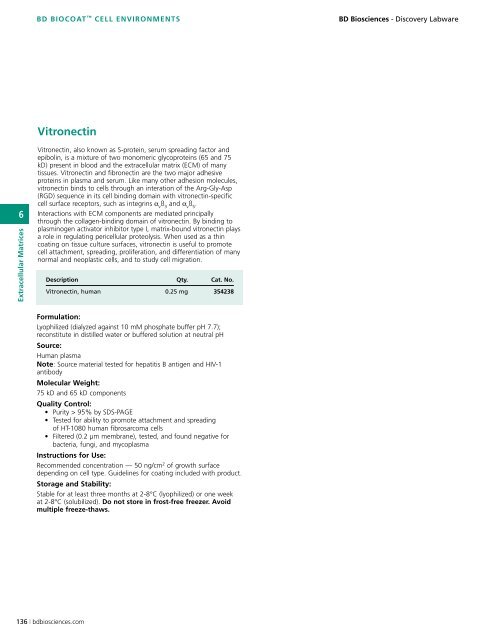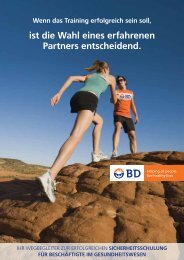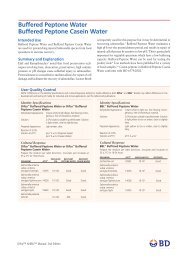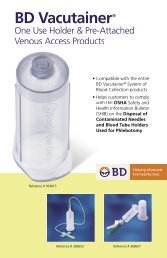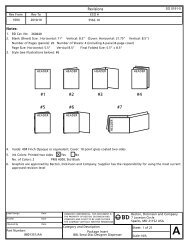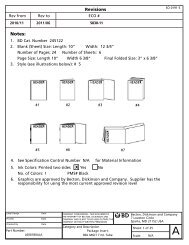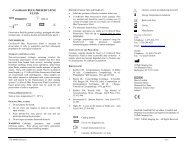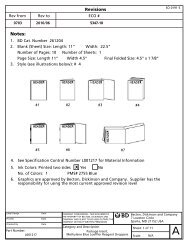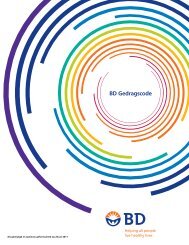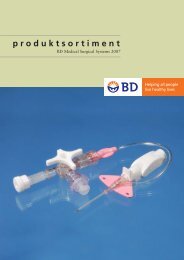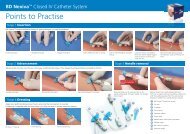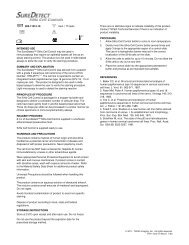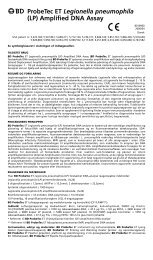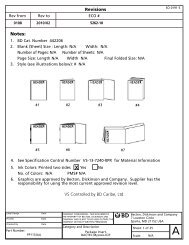Tubes - BD
Tubes - BD
Tubes - BD
Create successful ePaper yourself
Turn your PDF publications into a flip-book with our unique Google optimized e-Paper software.
6<br />
extracellular matrices<br />
<strong>BD</strong> Biocoat cell environments <strong>BD</strong> Biosciences - Discovery Labware<br />
vitronectin<br />
Vitronectin, also known as S-protein, serum spreading factor and<br />
epibolin, is a mixture of two monomeric glycoproteins (65 and 75<br />
kD) present in blood and the extracellular matrix (ECM) of many<br />
tissues. Vitronectin and fibronectin are the two major adhesive<br />
proteins in plasma and serum. Like many other adhesion molecules,<br />
vitronectin binds to cells through an interation of the Arg-Gly-Asp<br />
(RGD) sequence in its cell binding domain with vitronectin-specific<br />
cell surface receptors, such as integrins α v ß 3 and α v ß 5 .<br />
Interactions with ECM components are mediated principally<br />
through the collagen-binding domain of vitronectin. By binding to<br />
plasminogen activator inhibitor type I, matrix-bound vitronectin plays<br />
a role in regulating pericellular proteolysis. When used as a thin<br />
coating on tissue culture surfaces, vitronectin is useful to promote<br />
cell attachment, spreading, proliferation, and differentiation of many<br />
normal and neoplastic cells, and to study cell migration.<br />
Description Qty. cat. no.<br />
Vitronectin, human 0 .25 mg 354238<br />
Formulation:<br />
Lyophilized (dialyzed against 10 mM phosphate buffer pH 7.7);<br />
reconstitute in distilled water or buffered solution at neutral pH<br />
source:<br />
Human plasma<br />
note: Source material tested for hepatitis B antigen and HIV-1<br />
antibody<br />
molecular Weight:<br />
75 kD and 65 kD components<br />
Quality control:<br />
• Purity > 95% by SDS-PAGE<br />
• Tested for ability to promote attachment and spreading<br />
of HT-1080 human fibrosarcoma cells<br />
• Filtered (0.2 µm membrane), tested, and found negative for<br />
bacteria, fungi, and mycoplasma<br />
instructions for Use:<br />
Recommended concentration — 50 ng/cm 2 of growth surface<br />
depending on cell type. Guidelines for coating included with product.<br />
storage and stability:<br />
Stable for at least three months at 2-8°C (lyophilized) or one week<br />
at 2-8°C (solubilized). Do not store in frost-free freezer. avoid<br />
multiple freeze-thaws.<br />
136 | bdbiosciences.com


